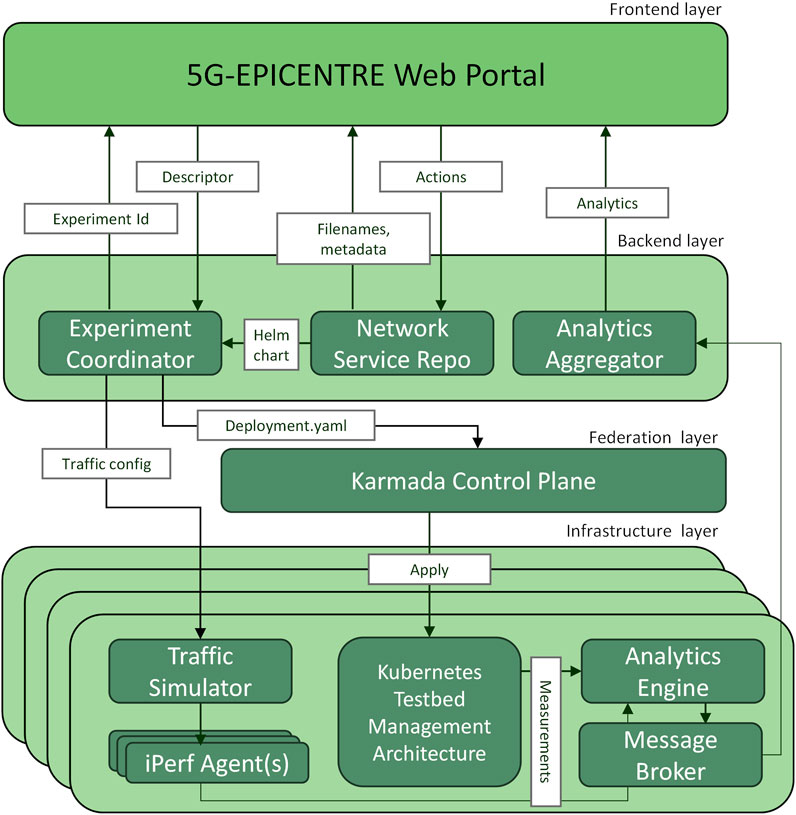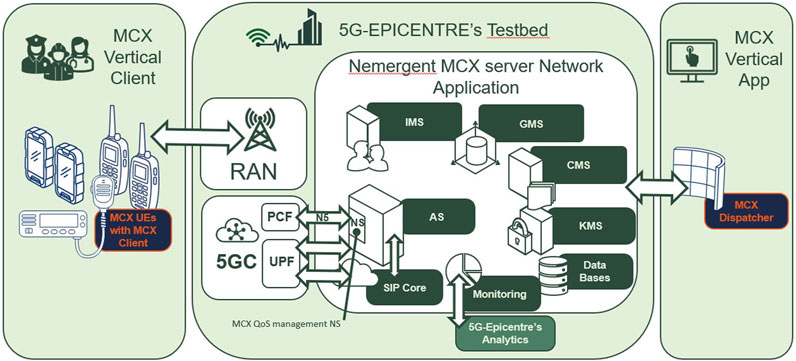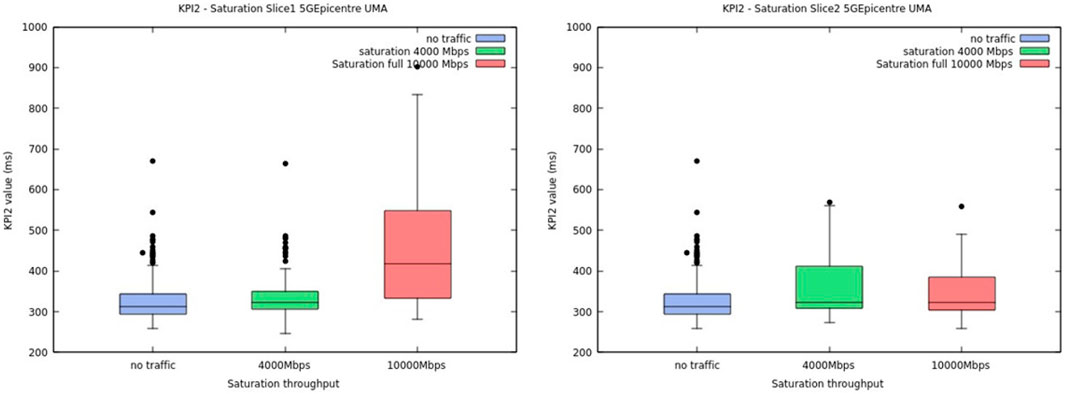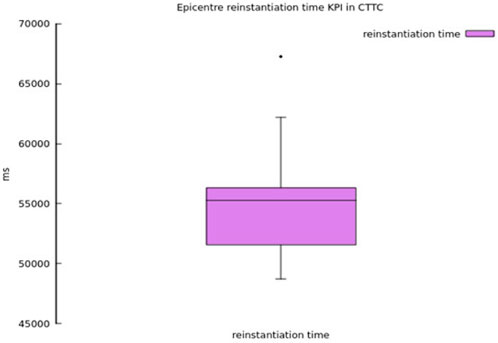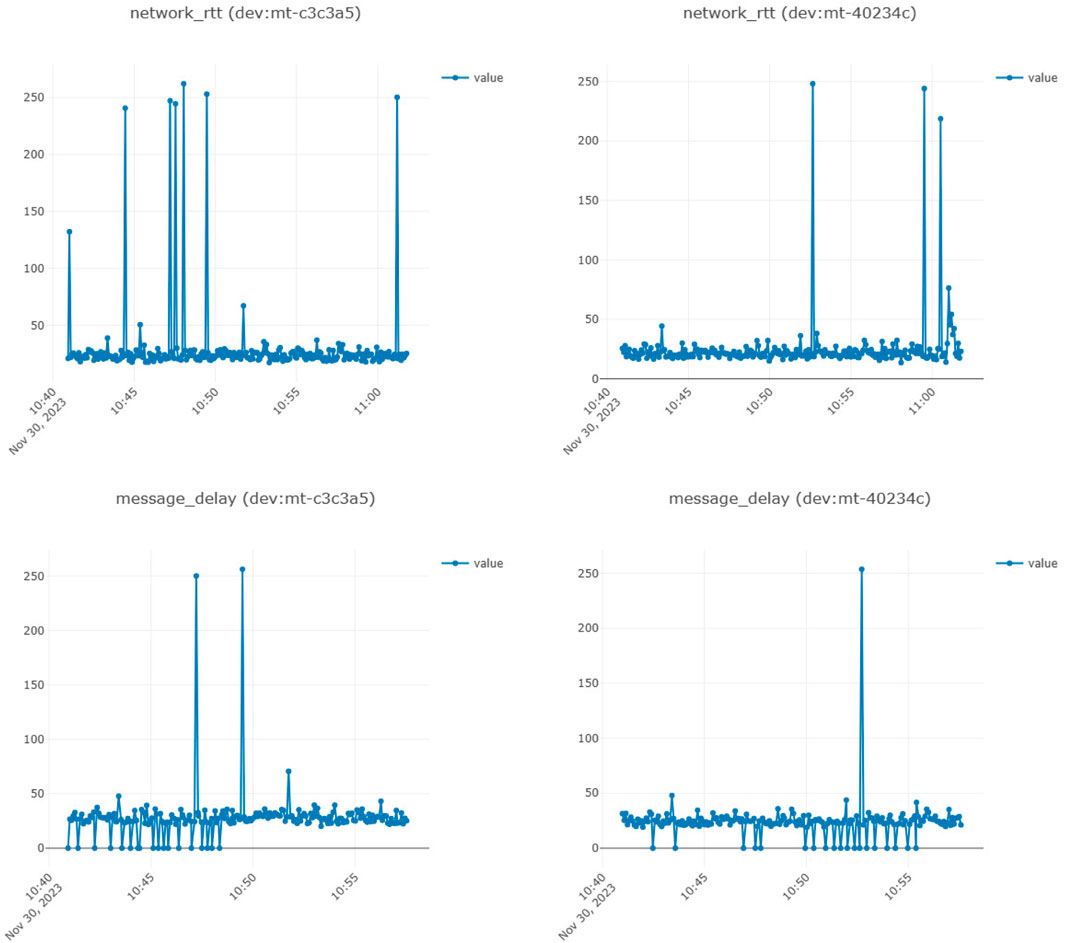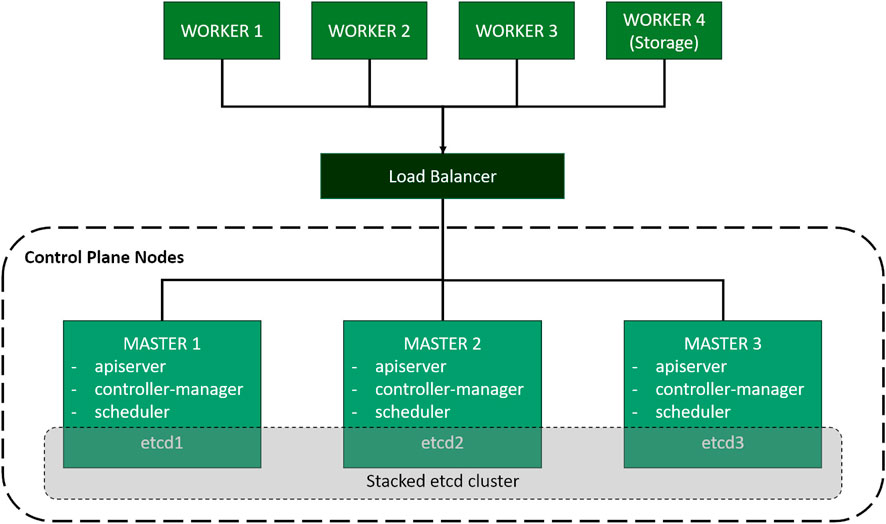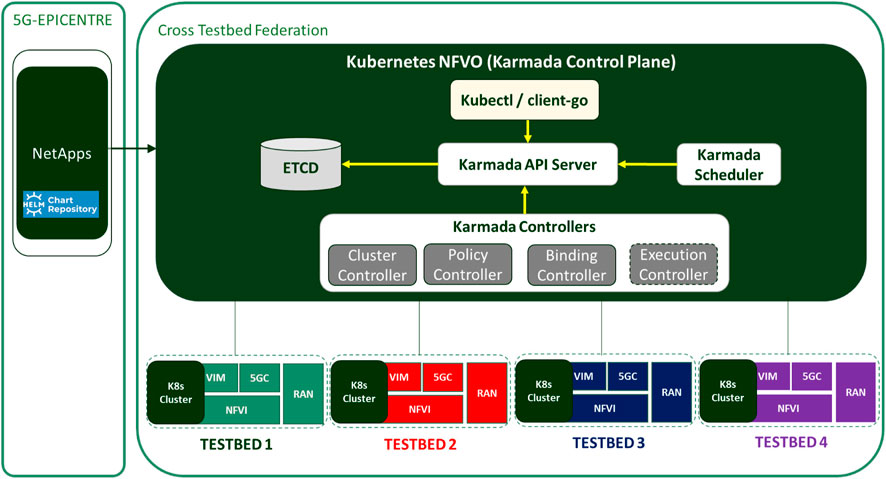A network application approach towards 5G and beyond critical communications use cases
- 1Institute of Computer Science, Foundation for Research and Technology-Hellas (FORTH-ICS), Heraklion, Greece
- 2ITIS Software, Universidad de Málaga, Málaga, Spain
- 3Athonet Research & Innovation, Hewlett Packard Enterprise, Bolzano Vicentino, Italy
- 4Nemergent Solutions SL, Bilbao, Spain
- 5ORamaVR SA, Geneva, Switzerland
- 6Department of Computer Science, University of Crete, Heraklion, Greece
- 7OneSource, Coimbra, Portugal
- 8SaS RU, Centre Tecnològic de Telecomunicacions de Catalunya (CTTC/CERCA), Barcelona, Spain
- 9Department of Electrical and Computer Engineering, University of Western Macedonia, Kozani, Greece
Low latency and high bandwidth heralded with 5G networks will allow transmission of large amounts of Mission-Critical data over a short time period. 5G hence unlocks several capabilities for novel Public Protection and Disaster Relief (PPDR) applications, developed to support first responders in making faster and more accurate decisions during times of crisis. As various research initiatives are giving shape to the Network Application ecosystem as an interaction layer between vertical applications and the network control plane, in this article we explore how this concept can unlock finer network service management capabilities that can be leveraged by PPDR solution developers. In particular, we elaborate on the role of Network Applications as means for developers to assure prioritization of specific emergency flows of data, such as high-definition video transmission from PPDR field users to remote operators. To demonstrate this potential in future PPDR-over-5G services, we delve into the transfer of network-intensive PPDR solutions to the Network Application model. We then explore novelties in Network Application experimentation platforms, aiming to streamline development and deployment of such integrated systems across existing 5G infrastructures, by providing the reliability and multi-cluster environments they require.
1 Introduction
The 4G standards have introduced several enablers for critical communications, with 5G promising to provide the PPDR community with the required service levels expected to deliver critical life-saving functions (Neto et al., 2022). Considering the sheer size of the data to be transmitted, alongside the challenging conditions in PPDR scenarios that will stress network capabilities, it is crucial to ensure that every data stream in PPDR mobile services can be transmitted over a 5G network, within a very short time frame and with guaranteed quality. To address such specific requirements by different 5G network tenants, a host of 5G Infrastructure Public Private Partnership (5G PPP) initiatives have worked over the past 3 years toward realising a vision for direct interaction of vertical-specific software and the 5G network control plane, under the collective term Network Applications (5G-PPP Software Network Working Group, 2022). For PPDR in particular, Network Applications can bring programmability of network slices to adjust their properties to the needs of 5G-enabled services developed for PPDR end-users (Apostolakis et al., 2021; Cordeiro et al., 2023).
Among the aforementioned projects, 5G-EPICENTRE (www.5gepicentre.eu) envisioned a dedicated and federated 5G PPDR experimentation facility, bringing together four heterogeneous 5G testbeds with the aim of aggregating their computational resources and making them available through a single point of access (Tabatabaei et al., 2023), for what has been a traditionally challenging vertical to develop for. The project embraced an Experimentation-as-a-Service (EaaS) approach (Kalogiros et al., 2019; Midoglu et al., 2021) from the very beginning, realizing a conceptual cloud-native framework for how such an online aggregator for 5G PPDR experiment ordering would be architected (Arampatzis et al., 2021); accumulating evidence on Kubernetes-based management and orchestration to support experiment deployment (Margetis et al., 2022); and demonstration of thorough management of 5G Quality of Service (QoS) Identifiers (5QIs) for PPDR applications by leveraging the project’s Network Application development paradigm (Cordeiro et al., 2023).
In this article, we explain how the Network Applications ecosystem and delivery model unlocks these transformative benefits of 5G technology for PPDR agencies and end-users. Section 2 provides a background of related work on Network Applications and 5G for PPDR in general. In Section 3, we elaborate on the Network Application approach and delivery model developed in the 5G-EPICENTRE project. We follow-up with a discussion on how Network Applications simplify 5G core network service exposure, and provide examples of enabling service guarantees, such as 5QIs management, which are crucial to ensure priority of specifically elected PPDR users’ communications over the network in case of destabilization issues (e.g., radio congestion). Then, we proceed to specify three novel PPDR vertical systems in Section 4, integrating Network Application architectures under different levels of interaction between vertical and platform application components, in order to take advantage of the more reliable connections that can be facilitated for Mission-Critical (MC) data, video, and other services transmission, as elaborated in Section 3. Afterwards, leveraging on common paradigms for Network Application implementation and deployment reported in the literature, in Section 5 we present key technological innovations for further drastically enhancing service reliability and access time through cloud architectures and microservices-oriented service orchestration, even on distributed network infrastructures. We conclude our paper by offering insight into what 5G and beyond networks can deliver to PPDR applications in Section 6.
2 Background and related work
Within the scope of the present paper, we identify in this Section works that address similar topics, most notably, how other initiatives have interpreted, formulated and implemented similar Network Application delivery models; as well as works that describe 5G and beyond innovations for PPDR environments, including experimentation and testbed findings for public-safety-oriented vertical systems.
2.1 5G Network Applications and their delivery model
Network Applications (abbreviated in some literature works as “NetApps”) are a particularly young topic in communications and network literature, kicked-off in the European Commission 2019 Framework Programme Call for Information and Communication Technologies under Topic ID ICT-41-2020 “5G PPP—5G innovations for verticals with third-party services”. In it, the concept is defined as chains of Virtual Network Functions (VNFs), linked together across domains to meet specific requirements of a 5G network tenant (European Commission, 2019).
Early works indeed interpret Network Applications as derivatives of the ETSI NFV specification, i.e., software packages, configured to execute Network Functions (NFs) (Patachia-Sultanoiu et al., 2021; Trichias et al., 2021). Through Service Function Chaining, network traffic can be directed to flow through one or more NFs, thus, forming more complex end-to-end network services out of NF chains. Network Applications harness these chains, either as standalone, or as building blocks of integrated software, to unlock more complex network services for vertical systems (Apostolakis et al., 2021; Arampatzis et al., 2021; Gallego-Madrid et al., 2022; Grigoriou et al., 2022; Martinez-Alpiste et al., 2022; Moscatelli et al., 2022; Porcu et al., 2022; Slamnik-Kriještorac et al., 2022). But beyond chaining VNFs, Network Applications are meant to enable verticals to exploit 5G network capabilities exposed through common Application Programming Interfaces (APIs), which in turn, simplifies large-scale deployment of their services. Thus, they act as “application enablement services”, exposing northbound interfaces for facilitating access to telco network resources (Siokis et al., 2021; Iordache et al., 2022; Koumaras et al., 2022; Pateromichelakis et al., 2022). Thereby, they fabricate middleware towards “network-aware” vertical applications, i.e., they implement the necessary interfaces for chained, or co-executed vertical applications, so that the latter can more easily consume methods exposed by the various elements of the 3GPP 5G architecture (e.g., 5GC, RAN, MEC). These collective contributions to the concept by the different projects funded under the ICT-41 Call topic (see Table 1) contributed to a 5G PPP White Paper, which concretely defines Network Applications as software facilitating an interaction layer between vertical applications and the network control plane (5G-PPP Software Network Working Group, 2022). Thus, Network Applications allow tenants to customise the network characteristics to execute a dedicated task for their vertical application, tailored to the needs of the specific end-user for whom the network slice is configured. Current research in Network Applications is focused on the northbound APIs that the network architecture exposes, along with means to simplify access for verticals, so that they harness the services exposed by, e.g., the control plane functions of the 5G Core (5GC) network (Fragkos et al., 2022; Sanchez et al., 2022; Charismiadis et al., 2023). Such service exposure will unlock capabilities for verticals in the 5G and beyond 5G era, including access to network data analytics collection (Pateromichelakis et al., 2022); mobility (Amponis et al., 2022) and 5G QoS management mechanisms (Gilson et al., 2022; Cordeiro et al., 2023).

TABLE 1. Projects funded under the ICT-41 topic, and their respective contributions to the Network Application definition.
In parallel to the concept being demystified, several initiatives placed emphasis on the Network Application ecosystem and delivery model, elaborating on framework design for integrating, deploying and experimenting with Network Applications in existing 5G facilities. Many projects classify Network Applications into vertical-specific and vertical-agnostic implementations (Patachia-Sultanoiu et al., 2021; Trichias et al., 2021). This way, they differentiate between software designed to address needs exclusive to a particular tenant, or software to meet requirements generated by several vertical industries. Thereby, solutions have been implemented that target different use cases in those industries, most notably the automotive (Bonea et al., 2021; Katsaros et al., 2022), maintenance (Giannakidou et al., 2022; Khadmaoui-Bichouna et al., 2022), and PPDR domains (Apostolakis et al., 2021; Margetis et al., 2022). To experiment with such solutions, several projects propose architectural frameworks (Arampatzis et al., 2021; Martinez-Alpiste et al., 2022) and experimental testbed facilities’ augmentations and workflows (Iordache et al., 2022; Margetis et al., 2022) to facilitate Network Applications’ deployment, in tandem to the vertical systems under test. A common paradigm, followed across 5G PPP initiatives, toward simplifying this implementation and deployment of Network Applications is the adoption of a DevOps (Development and Operations) methodology driven by a Continuous Integration/Continuous Delivery (CI/CD) practice (Patachia-Sultanoiu et al., 2021; Trantzas et al., 2021; Koumaras et al., 2022; Trantzas et al., 2022). These favour a workflow for microservices architectural-style design and containerized deployment of network services and applications (Grigoriou et al., 2022; Margetis et al., 2022).
2.2 European 5G research in PPDR
Advertised 5G technology capabilities, such as network slicing and Multi-access Edge Computing (MEC), have generated interest in the under-served European PPDR domain, simultaneously making this vertical commercially attractive to 5G stakeholders (Lemstra, 2018). While appropriate standards for the support of PPDR services were described in Release 15 of the 3GPP specifications, including Mission Critical Push To Talk (MCPTT) (third Generation Partnership Project, 2017a), Mission Critical Video (MCVideo) (third Generation Partnership Project, 2017b) and Mission Critical Data (MCData) (third Generation Partnership Project, 2018), EU public safety organisations continue to rely on legacy PPDR networks, such as TETRA, TETRAPOL, P25, and DMR (Neto et al., 2022). To incentivise a transition of PPDR services to commercial broadband networks, the benefits of 5G technology for this vertical are well-documented in the scientific literature (Franchi et al., 2022; Borsatti et al., 2023), as have several frameworks, tools, innovative systems and research projects, to address service requirements in the sector (Apostolakis et al., 2021; Arampatzis et al., 2021; Chochliouros et al., 2021; Margetis et al., 2022; Sterle et al., 2022). Therefore, research focus has now shifted towards delivering reliable and unquestionable experimental evidence regarding the practical offerings of 5G to critical communications use cases (Volk and Sterle, 2021; Borsatti et al., 2023).
To arrive at such corroborating results, several EU- and privately-funded initiatives have worked, or are working towards validating 5G-enabled use cases for PPDR vertical application scenarios, intent on demonstrating 5G capabilities that either improve, or facilitate new PPDR mobile services. A comprehensive overview of the state of affairs in 5G experimentation for PPDR across research projects up to 2021, is presented in Volk and Sterle (2021). Beyond those projects and findings, the 5G ESSENCE project is working towards demonstrating benefits of a 5G deployment on MCPTT and mission critical chat and localisation services (Chochliouros et al., 2021). The RESPOND-A project, on the other hand, has evaluated 5G capabilities and demonstrated the superior connectivity offered by 5G communications technologies in hands-on approach across different search-and-rescue scenarios with real end-users Paladin et al. (2023). The FUDGE-5G project (Gomez-Barquero et al., 2021) aims at contributing to the recent evidence surrounding the concept of the 5G “tactical bubble”, i.e., ad-hoc, dedicated mobile networks, intended solely for the vertical for which they are deployed (Suomalainen et al., 2021). More recently, newly funded initiatives FIDAL and 6G-SANDBOX announced plans to experiment with the 3GPP Common API Framework, to expose mission-critical services APIs (Charismiadis et al., 2023).
Within the context of the ICT-41 projects, 5G-ERA is working towards an intent-based networking solution over 5G to demonstrate how unmanned autonomous vehicles in PPDR scenarios can seamlessly migrate from one base station to another without disconnecting (Gavrielides et al., 2023). On the other hand, and pertinent to the work described in this paper, 5G-EPICENTRE dedicates 8 Network Application experimentation scenarios to PPDR use cases defined by innovators and researchers in the sector (Apostolakis et al., 2021), thus, acting as the reference project for 5G, and Network Application benefit demonstration for the PPDR vertical.
3 5G-EPICENTRE Network Application experimentation
Compared to previous generations, 5G aims to allow third parties (and elements external to the network) to interact more naturally and tightly with the network’s control plane. As specified in Section 2.1, Network Applications are characterized by their capability of inter-operating with the mobile network, allowing tenants to “shape” the network itself (whenever allowed) to fit (at best) their requirements. They further leverage standardized network interfaces and exposed network APIs to empower vertical service developers (such as those focused on PPDR solutions) with renewed control capabilities over the mobile network. Thus, Network Applications become instrumental to a more dynamic interaction between third parties and the network’s control plane. They simplify this interaction and concretise several network control mechanisms into standardized or widespread tools. As a result, mobile networks are more accessible to service developers from different technological fields, who can avail themselves of an enriched set of networking functionalities for the greater benefit of numerous use cases. As already mentioned, Network Applications allow users of these services to request dedicated network resource allocation; to obtain a guaranteed QoS over the network; to gather information (performance metrics, location, feedback, etc.) from other network elements and UEs, etc.
Following 3GPP specifications (third Generation Partnership Project, 2021a), Network Applications can operate on the control plane of the 5GC as (or via) Application Functions (AFs) and, through dedicated standardized 3GPP interfaces, they can leverage several network features. For instance, they can consume the services exposed by the Network Exposure Function (NEF) (third Generation Partnership Project, 2021b), among which we can enumerate a vast event monitoring capability or the possibility of configuring or provisioning control information about the UEs and the Radio Access Network (RAN). Furthermore, via the NEF, Network Applications can directly or indirectly influence traffic policies and routing decisions, e.g., to support edge computing or to perform QoS management, as will be discussed in Section 3.2. When “trusted” (third Generation Partnership Project, 2021a), AFs can interact with targeted 5GC NFs, also without the mediation of the NEF. Based on the aforementioned interaction capabilities, vertical services associated with the PPDR sector, particularly those that require special conditions in the 5G environment, can identify themselves and request specific conditions from the network, creating a value chain of NFs.
3.1 Network Applications integration in 5G-EPICENTRE
Software designed to address the needs of a specific network tenant will inevitably require experimental facilities to support stress testing and validation. As presented in Section 2.2, this becomes particularly important for PPDR applications, where the need to guarantee the uninterrupted exchange of voice, video, data and, especially under extreme network conditions, is vital to enable this vertical’s end users to carry out their duties. For stakeholders and decision-makers in this domain to invest in the 5G technology however (which entails replacing existing PPDR networks with broadband services), concrete evidence is necessary to demonstrate the superior aspects of these networks, and that they are fit for purpose (Critical Communications Association, 2019). Network Applications emerged to accelerate this process across all verticals, and thus signify an important shift in the implementation and deployment of vertical systems over 5G networks. However, the development or adaptation of software solutions and services to the Network Application model is not a trivial task. Therefore, novel software functions, features and implementations are needed, toward streamlining experimentation and valorization of 5G-enabled Network Applications by third-party developers and vertical end-users.
To spearhead deployment of Network Application-based developments for the PPDR vertical specifically, 5G-EPICENTRE has implemented the high-level experimentation infrastructure depicted in Figure 1. Four independent (i.e., characterized by different 5G standalone implementation and technologies) testbed facilities are federated under a typical Karmada control plane architecture (Federation layer, depicted in yellow) (Tabatabaei et al., 2023), each accommodating a K8s-based management architecture Margetis et al. (2022), to orchestrate and manage deployment and operation of containerized PPDR applications. A centralized, cloud-native experimentation platform is deployed on top of this federation, enabling access to each of the underlying testbeds’ resources Arampatzis et al. (2021). It is comprised of a centralized Back-end layer architecture (depicted in blue), in charge of orchestrating the commands necessary to facilitate the deployment of the vertical application under the specifically desired test conditions; and a Front-end layer, responsible for exposing a Platform-to-Consumer web application for experiment ordering, thus facilitating the interactions between the two foreseen actors of the platform, i.e., the solution providers/vertical experimenters and the testbed administrators.
In this organisational structure, support for Network Applications falls under the “Hybrid” interaction approach (5G-PPP Software Network Working Group, 2022), allowing verticals to exploit enablers for advanced service operations; usability of the 5G capabilities; and adjustment of networks for PPDR needs (see Figure 2). In this Section, we elaborate on the project’s views and definitions of the experimentation with Network Applications, which are aligned to the definition of the term given in the 5G PPP Software Network Working Group White Paper (5G-PPP Software Network Working Group, 2022). In the remainder of this article, we shall refer to the different entities that are involved in the experimentation activities in the following manner:
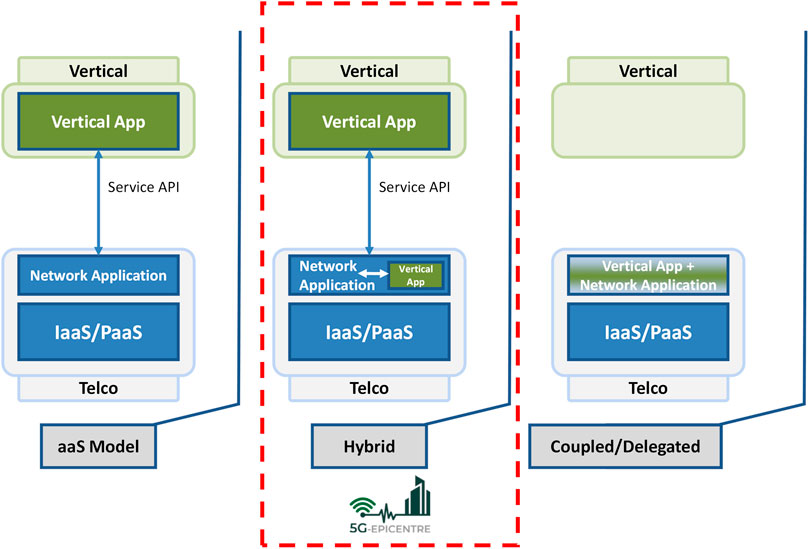
FIGURE 2. Options of interaction between vertical applications and Network Applications. Image adapted from 5G-PPP Software Network Working Group (2022), licenced under CC BY 4.0.
A Vertical System (VS) represents an end-to-end vertical solution developed by a “solution provider” in the EaaS business ecosystem (see Darzanos et al., 2022), which provides that vertical with Internet-connected services over a 5G network. In the context of the 5G-EPICENTRE project, solution providers deploy their VSs on top of the 5G-EPICENTRE infrastructure for experimentation and Key Performance Indicator (KPIs)’ validation (examples are presented in Section 4). A VS usually comprises several components, client applications and servers, that, according to the Network Applications integration approach, could reside in either the vertical service provider domain, and/or as adjacent services instantiated and managed by the entity operating the 5G (experimentation) infrastructure. In addition, VSs to be experimented with are composed of one or more Vertical Application (VA) components, which deliver vertical-specific functionalities and user experience, e.g., a front-end component (i.e., exposing a user interface). Additionally, they either integrate or consume the methods exposed by one or more Network Applications, which, as stated, provide vertical-specific, or vertical-agnostic services by abstracting the 5G network below in simple API calls.
Following this nomenclature, it is evident that Network Applications in 5G-EPICENTRE are considered tightly coupled with the experimentation facility architecture, offered by the experimentation infrastructure operator as an integration element that is meant to combine its services with those of the VA components as part of the EaaS offering Darzanos et al. (2022). However, the practice does not preclude the solution provider from transferring parts of the developed VS to the Network Application model, provided that such parts fit the description of the Network Application approach. Then, depending on the level of openness and interoperability, solution providers could offer usage of the Network Application part(s) of any VS they develop for others to experiment with, thus, complementing the EaaS offerings of the infrastructure operator (Darzanos et al., 2022).
3.2 QoS management for PPDR vertical systems via Network Applications
In 5G-EPICENTRE, Network Applications consume the northbound APIs from the control plane functions of Athonet’s (www.athonet.com) 5GC. Given the various PPDR-oriented use cases that the project experiments with, specific network features that PPDR vertical service developers (experimenters) are more likely to want to access and configure involve exercising QoS management over the network. Through Network Applications built into the experimentation infrastructure, experimenters can configure network properties and meet specific QoS requirements for their experiments. In this way, Network Applications can exercise QoS management over the network and guarantee privileged QoS to PPDR vertical services (Cordeiro et al., 2023). This can be leveraged to avoid QoS degradation in case of overloaded network resources. There are several benefits that are unlocked in this scenario for every actor in the 5G-EPICENTRE EaaS ecosystem:
• The performance of the experiment is optimized due to the alignment of the network properties with the desired QoS levels.
• Experimenters are empowered to prioritize and classify different types of network traffic and, thereby, ensure seamless and efficient execution of experiments on top of the 5G network.
• Experimenters are enabled to carry out their experiments with guarantee that the requested QoS will be met.
In terms of interaction with the 5GC control plane functions to achieve these outcomes, we focus on the possibility of VSs managing QoS policies through Network Applications adjacent to the 5G System and, in particular, to do so as trusted AFs by directly exploiting the N5 interface exposed by the Policy Control Function (PCF) (third Generation Partnership Project, 2021a). Via the PCF, AFs can control the QoS and induce the prioritization of targeted user traffic within the User Plane Function (UPF), at the Protocol Data Unit (PDU) session management level. Such configurations are implemented in the UPF as packet filters and are characterized by standard parameters that differentiate the so called “QoS flows” within PDU sessions. For each UE and each application, such parameters are forwarded to the UPF by the Session Management Function (SMF), instructed by the updates on traffic policies managed by the PCF and induced by the Network Application via the exposed PCF APIs. The steps towards the creation of an application session, to be used to determine and set session policies, are depicted in Figure 3.
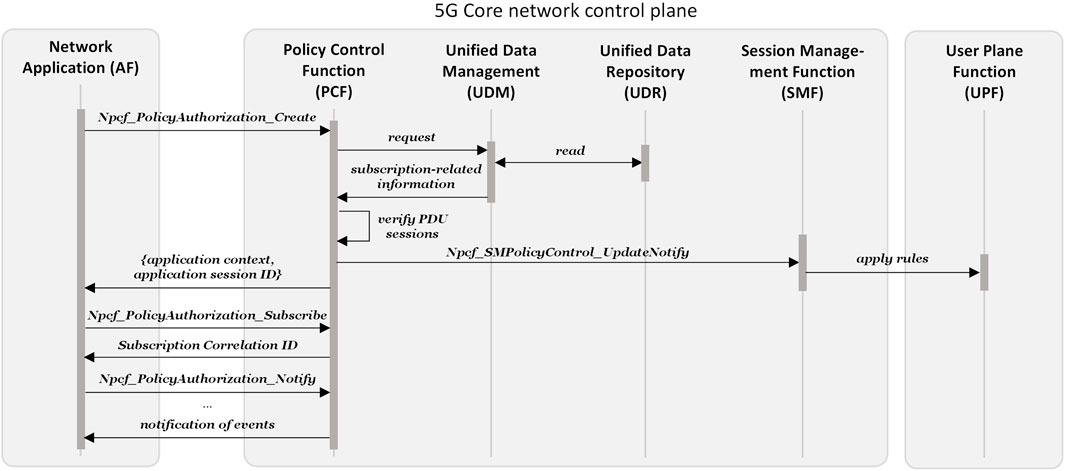
FIGURE 3. Example of PPDR Network Application interactions with 5G Core control plane functions for session creation and QoS policies determination.
As indicated in Figure 3, the AF may request a higher priority for certain video and/or data streams into a Npcf_PolicyAuthorization_Create request. Upon reception, the PCF identifies the need to update existing PDU sessions. If the defined policy allows it, the PCF will send a Npcf_SMPolicyControl_UpdateNotify request to the SMF, that will apply the needed rules into the UPF, thus, translating the changes into the QoS, initially requested by the AF.
4 Levels of interaction for PPDR vertical systems
Facilitating the interaction of PPDR vertical systems with 5G services is imperative to demonstrate to relevant operators and organizations that the new network is indeed MC capable (Critical Communications Association, 2019). To further accelerate the transition to broadband, it is also important to demonstrate advanced MC applications, which offer enhanced capabilities, and are able to address known challenges and current capability gaps inherent in the use of the current narrowband PPDR networks (Li et al., 2022). For this reason, one of the key objectives of the 5G-EPICENTRE project has been to demonstrate 5G features for a diverse range of MC applications and modern enablers, including real-time group communications, situational awareness platforms, and augmented reality solutions. To further take advantage of the opportunities that the Network Application interaction model has to offer, it has been necessary to adapt components of both existing and novel vertical PPDR-targeting services to fit the Network Application model described in Section 3.
In this Section, we present evidence on indicative PPDR use cases examined under 5G-EPICENTRE, and their corresponding VS architectures, harnessing Network Applications toward “programming” the network to fit their specific needs. Three distinct examples of integration and interaction between solution providers and testbed administrators are presented, to demonstrate flexibility of the proposed approach, and capacity to onboard vertical innovators with varying levels of knowledge about 5G. Thereby, the entry barrier to the 5G PPDR market can be significantly lowered for small/medium-sized enterprises and startup initiatives, whose focus can instead turn towards experimenting with their prototypes.
4.1 Tight coupling: Nemergent MCX solution
3GPP standard-compliant MC Voice (i.e., MCPTT), Video and Data services (collectively referred to as Mission Critical Everything—MCX (Borsatti et al., 2023)) are counted among the applications most likely to be affected by what 5G technologies have to offer. Leveraging years-long expertise in 3GPP standard-based mission-critical solutions in mobile broadband environments, Nemergent Solutions (a 5G-EPICENTRE Consortium Member, www.nemergent-solutions.com) has adapted its Nemergent Mission Critical Services offering of application-level components to the Network Application delivery model, in order to examine MCPTT, MCData and MCVideo in the context of a 5G network, to demonstrate and offer the advantages that 5G technology can bring to the PPDR sector and MCX communications in particular.
In its use case for the project, Nemergent explores agile and reliable 5G communication solutions for PPDR, embracing the MCX 3GPP standard for critical communications, data, video, and other services. It makes use of the virtual and physical service chain offered by a microservices-based Network Application architecture, which is integrated into an end-to-end MCX solution to form a VS, as defined in Section 3.1. The Nemergent VS is built by chaining containerised services and network elements as shown in Figure 4. It relies on a Network Application implementation of the 3GPP standards-aligned Nemergent MCX server solution, which is composed of an Application Server CNF (which can further be split into Participating and Controlling application servers); and several Management server containerized NFs (CNFs) for configuration, group, key and identity management (CMS, GMS, KMS, IdMS). Additionally to what the 3GPP defines as MCX components, this Network Application comprises additional CNFs for controlling services (such as databases) and an internal monitoring module, which can collect different metrics used to ensure service availability, scaling or redeployment of a new service, if necessary.
Because of its level of integration, this particular Network Application can be deployed in different ways, from the simplest over-the-top solutions to more complex hybrid integration that interact with the network infrastructure itself, as shown in Figure 2. Through CNFs controlling services, such as a Session Initiation Protocol Core (SIPCore), the Network Application offers infrastructure integration options and alternatives, that satisfy network owner’s needs.
In the 5G-EPICENTRE framework, among other Nemergent developments, a new Network Service (NS), MCX QoS management NS, has been developed, which, within the Network Application chain, exploits the N5 interface in the manner explained in Section 3.2, in order to offer traffic prioritisation to the MC Communications facilitated through the MCX server. In this manner, and powered by the capacity of the Network Applications’ interaction with the control plane functions of the 5GC, Nemergent’s VS enables QoS control over the 5G network prioritising MC traffic flows. In this architecture, the tight coupling of Network Application components within the VS itself, and with the testbed infrastructure operator integration elements is evident. This allows Nemergent to deploy its solution and, via requests, to impact the control plane of the network directly from its own VS.
4.1.1 Experimentation
Experimentation within 5G-EPICENTRE addresses the need for PPDR agencies to ensure network conditions in their MC communications, in the context of infrastructure sharing that is opened up by 5G technology and its new slicing feature. For this purpose, experiments were carried out with the MCX QoS management NS, alongside different slice parameterisations, applying different underlying traffic models and evaluating the results.
Early experiments offer a glimpse of how the service can be affected only with very high traffic models, and how the slice parameterised specifically for MC communications is not affected. The performance of an MCX service under demanding traffic conditions has been evaluated, comparing results, with and without slicing policies. Under these conditions, the MCPTT E2E Access Time (KPI2), defined in the 3GPP TS 22.179 V19.1.0 standard (third Generation Partnership Project, 2023), has been evaluated. Figure 5 shows the performance of the MCX service with different underlying traffic, with no slicing policies (left) and with slicing policies (right).
In phase 1 (left), performance is affected when the introduced traffic starts to be significant, obtaining a degraded KPI2 average value compared to phase 2 (right), where slicing policies were applied. The picture shows how a few samples in the worst-case scenario almost overcome the limit value defined in the standard for this KPI2, 1000 ms. However, thanks to the slicing, the MCX service is not affected by the same traffic, thus guaranteeing the needs of the first responders in the most demanding conditions, enabling them to act swiftly, even in complex emergencies.
Furthermore, the service virtualisation paradigm and deployment versatility which 5G technology enables, minimizes the required time for vital PPDR functionalities (such as service self-recovery, service re-instantiation by optimising network conditions and auto-scaling), to meet the most demanding needs. Thereby, a new MCX server Network Application is deployed from scratch in approximately 1 min, improving on other models (such as those based on VMs), where a similar deployment could take hours. The instantiation times achieved are shown in Figure 6. As this new deployment takes place in a multi-cluster K8s environment, where another instance of Nemergent’s MCX Network Application is already deployed, early evidence shows how two independent MCX VSs can communicate with each other, even when one has just deployed its Network Application in a separate cluster.
Through the 5G-EPICENTRE internal experimentation programme, the means by which an MCX-based Network Application can couple with the 5G network has been explored, in a way that improves the resilience of MC communications for PPDR verticals. This can be achieved on the one hand, by requesting specific resources and prioritising these communications over less critical ones, so that they are less affected by traffic; and on the other, exploring rapid deployments, thereby enabling agility of MCX services to adapt to the needs of a fully virtualised network.
4.2 Loose coupling: OneSource situational awareness platform
Alongside MCX services, MC Internet of Things (IoT) communications constitute a key objective of the 5G vision (Zhang and Fitzek, 2015). To demonstrate and validate the benefits of the Network Application delivery model for MC IoT systems, 5G-EPICENTRE Consortium Member OneSource (www.onesource.pt) integrates a situational awareness platform for Command and Control Centre PPDR operations, so as to obtain full awareness from the field during disaster response situations. It utilises the Mobitrust platform (Henriques et al., 2022), which allows command operators to monitor PPDR agents in the field. Data is automatically gathered from a variety of sensors integrated onto IoT devices (Body-Kit) worn by first responders on-site. It includes data from bio-sensors; geographical/indoor positioning; internal communication systems; vehicles; devices (e.g., drones); shared services (e.g., private websites or shared folders); and real-time text, audio and video transmissions.
Figure 7 depicts the Mobitrust VS architecture, demonstrating a looser coupling of Network and VA components, both with one another (i.e., leaning towards the “as-a-service” interaction option in Figure 2), as well as with the testbed integration elements. In this case, the VS is comprised of a variety of Network Application components, which are delegated to the infrastructure (End User Device Simulator, Message Broker, Relational Database, Time Series Database, Data Collector, Data Engine, Orchestrator, Monitor, Gateway, WebRTC Server and KPI Manager). A Portal service, which corresponds to the VA part of the VS remaining in the vertical service provider domain, leverages use of the aforementioned Network Application components via service API calls, and interfaces with the end-users via web interface, or smart device apps, allowing PPDR end users at Command Control Centre (CCC) or at mobile CCC (i.e., on site) to leverage the features provided by the Mobitrust application.
Through a dedicated module integrated into the Orchestrator Network Application component, Mobitrust can interact with the 5GC, presenting itself as an AF, and can request changes to the QoS provided by the 5G network, as described in Section 3.2. Through this feature, the VS can improve the quality of video and data streams originating at the first responders’ Body-Kit devices.
4.2.1 Experimentation
Leveraging 5G for unlocking the benefits of edge computing, this use case explores how Mobitrust services can be set up as close to PPDR end-users as possible, to achieve a higher awareness of the field operations. This is enabled by increasing the quality of audio/video streams received in the central controllers, as well as reducing the latency of those and other streams (e.g., sensors data). When both factors are combined, the awareness of the field operations increases, and quick actions might be triggered in response to a variety of alerts that are generated by the application.
Experimentation results attest to the advantages that 5G technology and the Network Application delivery model offer to the Mobitrust platform, namely, in scenarios with dedicated slicing mechanisms. Recent experimentation activities at the 5G-EPICENTRE Málaga platform have validated achievement of the following target KPIs (Figure 8):
• Network round-trip-time (RTT), reaching 29.50 ms for a congested slice, and 24.87 ms for a dedicated slice (on average);
• Messages Delay, achieving 28.25 ms for a congested slice and 24.20 ms for a dedicated slice (on average).
Additionally, the same parameters have also been collected in scenarios with direct and non-direct view to the antenna, with the platform’s KPI system registering values of 20.98 ms and 19.95 ms for the Network RTT in scenarios with direct and non-direct view to the antenna respectively, whereas values of 24.69 ms and 22.38 ms were registered for Messages Delay for the scenarios with direct and non-direct view to the antenna.
4.3 Platform-agnostic: ORamaVR AR solution for first-aid responders
Mobile Augmented Reality (AR) applications are among the technologies expected to benefit the most from the wide deployment of 5G networks (Qiao et al., 2019). With a strong track record in medical extended reality (XR) training, 5G-EPICENTRE Consortium Member ORamaVR (www.oramavr.com) is developing a real-time remote AR 3D rendering and streaming VS in the context of PPDR. The system entails the use of light-processing, portable, and battery-efficient AR Head-Mounted Displays (HMDs), allowing first-responders to view deformable 3D objects (bones, vessels, organs, etc.) overlaid on top of an injured person’s body at a disaster site. The AR VS provides real-time, step-by-step instructions for a set of PPDR-oriented critical surgical operations, complementing the first-responders’ medical skills on the field, ultimately allowing them to save human lives in emergencies.
The VS leverages two interconnected value chains of NFs integrating the company’s proprietary MAGES Software Development Kit (Zikas et al., 2023). The first chain is installed on the AR HMD, whereas the second is deployed on a suitable edge node. The AR HMD chain is responsible for recording and transmitting user events; transformations; and triggers to the edge components; and also for decoding and projecting the rendered stream. The edge application server will maintain the AR scene update function; physics calculations on deformable objects; AR scene rendering reacting to user input; and the encoding/compression and streaming of the produced video. The above described pipeline consists of a number of interconnected VA components, depicted in Figure 9. Specifically, the deployed VA used for ORamaVR’s AR use case (depicted in a red dashed box), runs on network edge resources, whereas the HMD executes the respective user-facing VA. The latter can be configured to receive the video stream from various XR streaming services, such as Air Light VR (Zaglia, 2023), incorporated in the VS.
The specific implementation of this intensive AR pipeline, with such strict latency and bandwidth requirements, showcases the capacity of the proposed Network Application delivery model to support similar VA deployments, which do not necessarily interact directly with the 5GC, RAN, or MEC interfaces (i.e., with some integrated service or component, as described in the tight, and loose coupling cases). This characteristic is quite common in many applications that were originally designed without considering their transition to a cloud-native approach and the exploitation of 5G networks. To accommodate such cases within the 5G-EPICENTRE innovation framework, the overall connection of the VS with the 5G functionalities can be established through a singular point, where the VS consumes the service APIs of a platform owner-provisioned Network Application. This Network Application is part of the EaaS offering of the particular 5G-EPICENTRE testbed infrastructure operator, on whose platform ORamaVR’s VS is deployed, and is responsible for facilitating direct interaction with the 5GC, RAN, or MEC interfaces. This enables translating and conveying the network resource requirements of the VS to the 5G network, in order to allocate these resources to the VS.
4.3.1 Experimentation
ORamaVR’s experiments target benefits of the proposed techniques for real-time, networked AR-based applications, an especially challenging task, since the AR rendered streams must always be in complete sync with the real space (AR user triggers and interactions). In that respect, a high fidelity and quality video stream must constantly be transmitted to the AR HMD with minimal latency. Such an AR utility imposes a great CPU and GPU processing burden, which, in cases of monolithic applications deployed within the HMD, would drain the battery very fast. Therefore, the proposed VS implementation offloads the XR pipeline’s heavy-duty processes (rendering/physics) to the edge-cloud continuum, while exploiting the low latency and high bandwidth support that 5G networks offer, for the streaming of the produced video back to the AR HMD.
In a series of remote experiments conducted at the Málaga platform, significant success was achieved in optimizing the performance of the VS implementation. Notably, a high bitrate of approximately 500 Mbps was successfully attained during the Network-stress experiment, with the 5G network demonstrating a mean throughput of 408 Mbps and a low average latency of 10.68 ms, surpassing the limitations of 4G networks (see Figure 10). With an average packet loss rate of 75%, and a non-existent Quality of Experience (QoE) for the AR user the experiment laid the foundation for further exploration. Subsequent QoE-driven experiments aimed at delivering an optimal AR experience for first-aid responders by reducing the bitrate to 50–100 Mbps. Remarkably, a stable throughput averaging 68.56 Mbps and a mean latency of 10.63 ms were consistently maintained over an extended period of time (see Figure 11). The experimenter reported a remarkable QoE with a high framerate, minimal stuttering, and lag in the video stream, identifying the “sweet spot” that optimizes user immersion and satisfaction in AR applications leveraging the low latency offered by 5G networks, despite the increased packets lost (on average 60%.
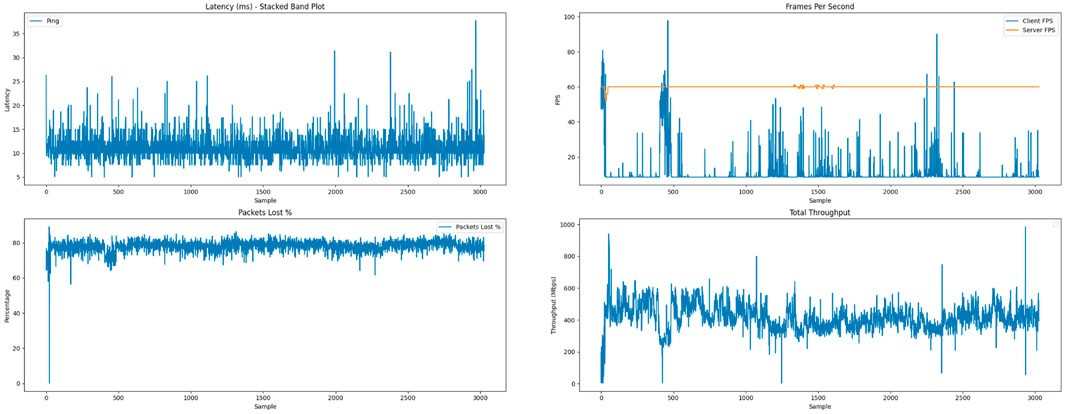
FIGURE 10. Results from the ORamaVR AR Solution on a testbed, with a high bitrate setting of 500 Mbps. The results of the experiment demonstrate the ability of streaming such an amount of data to the HMD via the 5G network, within minimal latency. The packet loss is increased as the HMD is unable to process the large amount of data received (as well as some network connectivity issues), leading to minimal QoE, as the rendered FPS on the HMD drop to zero, despite the proper rendering of the scene on the application hosted on the edge.
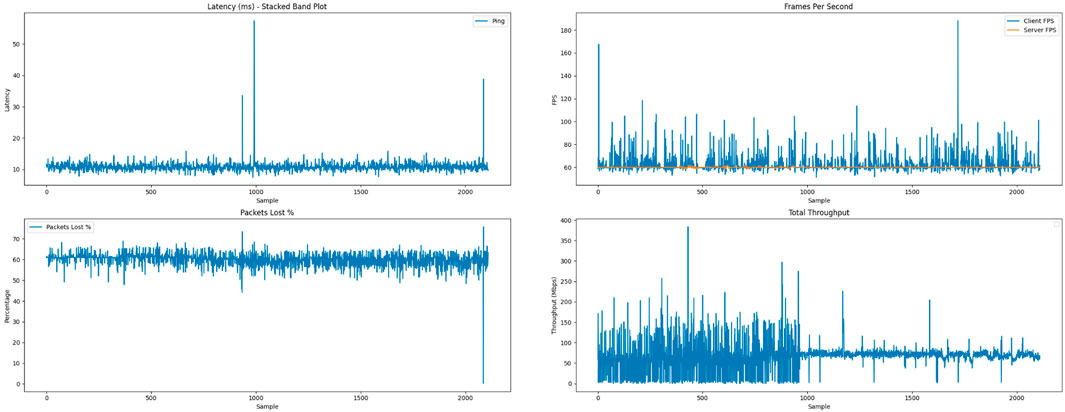
FIGURE 11. Results from the ORamaVR AR Solution on a testbed, with a lowee bitrate setting of 100 Mbps. The results of the experiment demonstrate the ability of streaming such an amount of data to the HMD via the 5G network, within minimal latency. Despite the packet loss, caused by the HMDs inability to process such large amount of data received as well as some network connectivity issues, we achieve remarkable QoE for the AR user. This is also indicative by the rendered FPS we manage to achieve on the HMD.
Concluding the experimental phase, the VS implementation demonstrated commendable outcomes, achieving a 30% extension in the HMD battery life for first aid responders, enhancing on-site usability. However, the experiments highlighted challenges in current-generation headset technology handling increased bitrates greater than 300 Mbps, leading to unacceptable QoE even with mid to high-range headsets. Future experiments, including the use of advanced headsets like Quest 3, will explore overcoming these limitations for optimal high-quality and high-fidelity AR experiences.
5 Enabling technologies for Network Applications
Apart from the shift to a Network Application delivery model, evidence from the studies reported in Section 4 (along with others conducted in the context of the 5G-EPICENTRE project), reveals that migrating towards a cloud-native, container-based testbed architecture represents an important step in the transformation of current 5G experimental facilities for supporting Network Applications. Harnessing the maturity of micro-services deployment solutions, such as Kubernetes (K8s) for the management and orchestration (MANO) of CNFs, benefits can be gained, among others, in Network Application service deployment time (Margetis et al., 2022). In addition, resource fragmentation is addressed through a federation of multiple K8s-based experimentation facilities via multi-cluster container deployments, enabled by Karmada (Karmada, 2023) K8s management and federation tools (Tabatabaei et al., 2023). This way, different Network Applications can be deployed and run concurrently without compromises. In this Section, we share insight on these potentially transformational cloudification technologies to manage the lifecycle of VSs and Network Applications, in order to facilitate the adoption of these Network Applications as a concrete part of the 5G and beyond ecosystem.
5.1 Cloud-native network application testbed architecture
A cloud-native architecture provides the means to deploy, manage, test, and operate Network Applications and their underlying infrastructure. Bearing this in mind, we have designed such an architecture to provide high availability and redundancy for MC deployments, features that are essential to any MC application. Thus, the proposed architecture rests on a multi-master, multi-node, K8s-based infrastructure. As shown in Figure 12, a representative cluster includes at least four worker nodes and three control plane nodes.
In order to properly distribute the services, all the nodes are deployed on a dedicated environment that integrates different physical servers running Ubuntu OS. The container runtime in use is containerd. Regarding network specifications, Calico is used as the Container Network Interface (CNI), combined with the Nginx ingress controller and MetalLB for load balancing. The purpose of the CNI is to configure the containers’ network interfaces, for which Calico offers enforcement of security policies besides connectivity between workloads. As described earlier, a Network Application is a chain of functions, both physical and virtual and, thus, some micro-services might be out of the cloud-native infrastructure. Taking this into account, the ingress provides them access to the services in a cluster, exposing the routes from outside the cluster to the internal services. For this purpose, the Nginx controller uses NGINX as a reverse proxy and load balancer. Additionally, MetalLB is used to integrate bare-metal clusters and standard network equipment, and to expose the Network Applications with services declared as LoadBalancer type, which are better suited than NodePort or ClusterIP type for production environments.
Following the reference implementation in (Margetis et al., 2022), in which both CNFs and VNFs are managed by Kubernetes, the KubeVirt plugin allows the deployment of VMs on top of this infrastructure. Also, when an experiment is launched, a Helm chart is built, creating a chain with every micro-service and network component needed. Thus, application and management servers, data bases, and the 5G infrastructure are deployed in the corresponding testbed according to the Helm chart.
For persistent storage, we have installed GlusterFS in the worker nodes, and a Heketi server for volumes’ dynamic provision. GlusterFS is a highly scalable data filesystem. By installing the system in every worker node, we ensure resiliency. Additionally, Heketi is a management interface to control the lifecycle of GlusterFS volumes. One of the workers (the “Storage” worker in Figure 12) is the main storage node, while the rest ensure continuity of service in case of failure. Heketi identifies them as endpoints for the persistent storage volume creation, processing the volume claims, and directing them to the GlusterFS service.
Concerning Network Application monitoring, an instance of Prometheus is deployed as part of the infrastructure, which connects to a RabbitMQ message broker to publish data retrieved from the experiments via MQTT queues. These handle the interchange of measurements reported by the testbed’s components and the Network Applications under test. The measurement messages format and routing key for connecting to the right MQTT queue are provided to the Network Application owner. Finally, an analytics engine retrieves the measurements from the MQTT queues and sends the output of its analysis to platform visualization modules.
The multi-master approach guarantees high availability through a proxy acting as the K8s API, balancing queries from the Network Applications among the control plane nodes. Furthermore, to avoid resources and security issues, from a use case spreading across the whole installation, we ensure isolated deployments by using one namespace per use case.
To interact with the K8s cluster, the Network Application owner should establish its namespace as the context of the deployment, the service account provided for the authentication, and the high-availability proxy address as the K8s API. Once this setup is performed, the Network Application owners can interact with the cluster by sending YAML files through a kubectl command-line tool. For instance, if the Network Application includes a Pod (which is the smallest deployable unit in a K8s environment) requiring persistent storage, that Pod’s YAML should define a claim that the platform will handle through the Heketi server, to automatically create and bound a GlusterFS volume to that Pod. Moreover, if the Network Application interacts with external components, the experimenter must create a YAML describing a LoadBalancer service, which assigns an address from the MetalLB IP address pool that will expose that Pod to the network, making it reachable to everyone in and out of the cluster.
5.2 Cross-testbed experimentation via multi-cloud MANO
With Network Function Virtualization (NFV) shifting towards a cloud-native architecture, the capacity to unlock the benefits of a multi-cloud (i.e., multi-cluster) deployment and NFV-MANO in the context of 5G features (e.g., slicing) can be practically explored (Osmani et al., 2021). We contemplate such a cross-testbed MANO solution layered on top of four 5G testbeds (see Figure 13), thus, enabling the definition and execution of Network Application experiments across multiple K8s clusters. It uses the K8s API to implement the interface with the clusters deployed in each individual 5G platform.
Within 5G-EPICENTRE, such a testbed federation solution is being realized as a K8s-based NFV orchestrator (NFVO), which manages and provides access to service resources in each federated experimentation facility (Tabatabaei et al., 2023). In turn, it provides multi-cluster K8s orchestration across different domains, thus allowing multi-cluster testbed federation, hence making it look as a single testbed from the point of view of the user deploying its services. The proposed NFVO solution is built around the Karmada management system (Karmada, 2023), which allows cloud-native applications to be deployed across multiple K8s clusters in the same way they would be deployed with K8s; without changing any parameters, or affecting the application executed in a cluster. Essentially, Karmada introduces the concept of cluster federation, allowing the pooling of K8s resources across different testbed infrastructures, thus establishing a new abstraction layer termed the federation layer.
Karmada allows access to the facilities federated under 5G-EPICENTRE by wrapping different aspects of each testbed API under a unified information model. It allows 5G testbeds to federate without losing control of their resources. This enables a global control of the deployment and adapting to the specificities of each cluster. It further enables the management of testbed components from a single layer, which allows managing multi-cluster deployments in the same way as single cluster deployments. It also combines available resources to achieve different experimentation on a different scale, hence offering a wider experimentation framework to experimenters. The management framework also offers flexibility in various aspects. First, its plug-in based architecture allows (de-)activating or modifying certain functionality (e.g., custom scheduling plug-ins can be introduced). There are multiple plug-ins involved in the deployment of services, e.g., those checking cluster affinity, or filtering and scoring clusters based on available resources, for instance. In brief, all above features allow consuming the services offered by the whole multi-testbed 5G-EPICENTRE infrastructure and deploying Network Applications from a single interface whilst enabling customized operations through its flexible architecture.
6 Conclusion and future work
In this article, we have explored 5G capabilities combined with novel PPDR functions, that can interact with the 5GC control plane under the novel Network Application concept. In this respect, we presented the adaptation of three 5G-enabled PPDR mobile applications to the Network Application model. We further examined how transitioning to the Network Application paradigm can be accelerated through experimentation facilities with support for cloud-native architectures; VNF containerization; K8s as the MANO stack; and extending cross-testbed Network Application experimentation via multi-K8s Network Application deployments managed by Karmada.
Early experimental evidence in each of the three described VSs attests to the improvements offered through both the Network Application model and key enabling technologies, both of which were elaborated in this paper (Sections 3 and 5). Through these (and other) experiments, 5G-EPICENTRE partners are contributing more evidence on the benefits of 5G for functionalities crucial to PPDR networked solutions, in way of enhanced network capacity; better slicing mechanisms; and better handling during spike periods. This is projected to help PPDR service developers to deal with the high flow of data that is foreseen for future mobile communications, especially in PPDR scenarios. We are currently evaluating the impact of the proposed Network Application interaction with the 5GC, for QoS management and 5G slicing in stressed network conditions; the deployment versatility and cross-domain coordination and communication for PPDR agencies mobilized in the emergency areas; and edge instantiation of PPDR services.
In the future, we aim at demonstrating more thorough management of 5QIs for PPDR applications. Furthermore, we aim at scaling the proposed Network Application approach through third-party experimentation activities, which would adapt to the different levels of interaction developed internally within the project.
Data availability statement
The original contributions presented in the study are included in the article/Supplementary Material, further inquiries can be directed to the corresponding author.
Author contributions
KA: Conceptualization, Funding acquisition, Methodology, Project administration, Supervision, Writing–original draft, Writing–review and editing. BV-M: Investigation, Methodology, Software, Writing–original draft, Writing–review and editing. NP: Conceptualization, Resources, Writing–original draft, Writing–review and editing. PG: Formal Analysis, Investigation, Software, Validation, Writing–review and editing. DT: Conceptualization, Project administration, Writing–original draft, Writing–review and editing. MK: Investigation, Software, Validation, Writing–original draft, Writing–review and editing. PT: Investigation, Writing–original draft, Writing–review and editing. HK: Writing–original draft, Writing–review and editing. LP: Writing–review and editing. AZ: Conceptualization, Methodology, Project administration, Supervision, Writing–review and editing. AP: Investigation, Software, Validation, Writing–review and editing. GM: Conceptualization, Funding acquisition, Writing–review and editing. JM-B: Investigation, Writing–review and editing. MR-E: Investigation, Writing–review and editing. AG: Investigation, Writing–review and editing. LC: Investigation, Writing–review and editing. GP: Supervision, Writing–review and editing. CS: Funding acquisition, Supervision, Writing–review and editing.
Funding
The author(s) declare financial support was received for the research, authorship, and/or publication of this article. This project has received funding from the EU’s Horizon 2020 innovation action program under Grant agreement No 101016521 (5G-EPICENTRE).
Acknowledgments
The authors would like to acknowledge the contributions of Alain Dubois (5G-EPICENTRE Project Coordinator) and Olivier Bouvier, both with Airbus DS SLC, France, a 5G-EPICENTRE Consortium Partner, who aided in the various efforts of the authors. We would also like to thank the reviewers for their constructive comments and efforts towards the improvement our manuscript’s impact and comprehensibility.
Conflict of interest
At the time of writing, NP was employed by Athonet SRL, which was acquired by Hewlett Packard Enterprise during the time of research. PG and DT were employed by Nemergent Solutions SL. MK, AP, and GP were employed by ORamaVR SA. PT, AG, and LC were employed by OneSource.
The remaining authors declare that the research was conducted in the absence of any commercial or financial relationships that could be construed as a potential conflict of interest.
Publisher’s note
All claims expressed in this article are solely those of the authors and do not necessarily represent those of their affiliated organizations, or those of the publisher, the editors and the reviewers. Any product that may be evaluated in this article, or claim that may be made by its manufacturer, is not guaranteed or endorsed by the publisher.
References
Amponis, G., Lagkas, T., Zevgara, M., Katsikas, G., Xirofotos, T., Moscholios, I., et al. (2022). Drones in B5G/6G networks as flying base stations. Drones 6, 39. doi:10.3390/drones6020039
Apostolakis, K. C., Margetis, G., Stephanidis, C., Duquerrois, J.-M., Drouglazet, L., Lallet, A., et al. (2021). “Cloud-native 5G infrastructure and network applications (NetApps) for public protection and disaster Relief: the 5G-EPICENTRE project,” in Joint European Conf. on Networks and Communications & 6G Summit (EuCNC/6G Summit), 235–240. doi:10.1109/EuCNC/6GSummit51104.2021.9482425
Arampatzis, D., Apostolakis, K. C., Margetis, G., Stephanidis, C., Atxutegi, E., Amor, M., et al. (2021). “Unification architecture of cross-site 5G testbed resources for PPDR verticals,” in 2021 IEEE International Mediterranean Conference on Communications and Networking (MeditCom). 13–19. doi:10.1109/MeditCom49071.2021.9647591
Bonea, A., Patachia-Sultanoiu, C., Iordache, M., Constantin, I., Radulescu, A., Comsa, C. R., et al. (2021). “Automated onboarding, testing and validation framework for NetApps,” in 2021 International Symposium on Signals, Circuits and Systems (ISSCS), 1–4. doi:10.1109/ISSCS52333.2021.9497420
Borsatti, D., Grasselli, C., Contoli, C., Micciullo, L., Spinacci, L., Settembre, M., et al. (2023). Mission critical communications support with 5G and network slicing. IEEE Trans. Netw. Serv. Manag. 20, 595–607. doi:10.1109/TNSM.2022.3208657
Charismiadis, A.-S., Salcines, J. M., Tsolkas, D., Guillen, D. A., and Rodrigo, J. G. (2023). “The 3GPP Common API framework: open-source release and application use cases,” in 2023 Joint European Conference on Networks and Communications & 6G Summit (EuCNC/6G Summit), 472–477. doi:10.1109/EuCNC/6GSummit58263.2023.10188337
Chochliouros, I. P., Spiliopoulou, A. S., Lazaridis, P. I., Zaharis, Z. D., Spada, M.-R., Pérez-Romero, J., et al. (2021). 5G for the support of public safety services. Wirel. Personal. Commun. 120, 2321–2348. doi:10.1007/s11277-021-08473-5
Cordeiro, L., Tomás, P., di Pietro, N., Atxutegi, E., and Díaz Zayas, A. (2023). Quality of service control Mechanisms to support PPDR network Applications in 5G and beyond. 2023 EuCNC & 6G summit - posters. Available at https://www.5gepicentre.eu/wp-content/uploads/2023/06/Cordeiro23_QoS_Control_Mechanisms_Support_PPDR_NetApp_5G_Beyond_final.pdf.
Critical Communications Association (2019). PPDR Roadmap for evolution from LMR/PMR to 4G/5G. White paper.
Darzanos, G., Kalogiros, C., Stamoulis, G. D., Hallingby, H. K., and Frias, Z. (2022). “Business models for 5G experimentation as a service: 5G testbeds and beyond,” in 2022 25th Conference on Innovation in Clouds, Internet and Networks (ICIN), 169–174. doi:10.1109/ICIN53892.2022.9758131
European Commission (2019). 5G PPP – 5G innovations for verticals with third party services. https://ec.europa.eu/info/funding-tenders/opportunities/portal/screen/opportunities/topic-details/ict-41-2020.
Fragkos, D., Makropoulos, G., Gogos, A., Koumaras, H., and Kaloxylos, A. (2022). “NEFSim: an open experimentation framework utilizing 3GPP’s exposure services,” in 2022 Joint European Conference on Networks and Communications & 6G Summit (EuCNC/6G Summit), 303–308. doi:10.1109/EuCNC/6GSummit54941.2022.9815829
Franchi, F., Marotta, A., Rinaldi, C., Graziosi, F., Fratocchi, L., and Parisse, M. (2022). What can 5G do for public safety? Structural health monitoring and earthquake early warning scenarios. Sensors 22, 3020. doi:10.3390/s22083020
Gallego-Madrid, J., Sanchez-Iborra, R., and Skarmeta, A. (2022). From network functions to NetApps: the 5GASP methodology. Comput. Mater. Continua 71, 4115–4134. doi:10.32604/cmc.2022.021754
Gavrielides, A., Sophocleous, M., Lessi, C. C., Agapiou, G., Špaňhel, J., Lendinez, A., et al. (2023). “Implementing network applications for 5G-enabled robots through the 5G-ERA platform,” in Artificial intelligence applications and innovations. AIAI 2023 IFIP WG 12.5 international workshops. Editors I. Maglogiannis, L. Iliadis, A. Papaleonidas, and I. Chochliouros (Cham: Springer Nature Switzerland), 55–65.
Generation Partnership Project (2017a). 3GPP TS 22.179: mission critical Push to Talk (MCPTT);Stage 1(release 15). Technical specification. Rev. 15.2.0.
Generation Partnership Project (2017b). 3GPP TS 22.281: mission critical Video services (Release 15). Technical specification. Rev. 15.1.0.
Generation Partnership Project (2018). 3GPP TS 22.282: mission critical data services Release 15. Technical specification. Rev. 15.1.0.
Generation Partnership Project (2021a). 3GPP TS 23.501: system Architecture for the 5G system (5GS); stage 2 (Release 16). Technical specification. Rev. 16.11.0.
Generation Partnership Project (2021b). 3GPP TS 23.502: procedures for the 5G system (5GS); stage 2 (Release 17). Technical specification. Rev. 17.3.0.
Generation Partnership Project (2023). 3GPP TS 22.179: mission critical Push to Talk (MCPTT);Stage 1(release 19). Technical specification. Rev. 19.1.0.
Giannakidou, S., Radoglou-Grammatikis, P., Koussouris, S., Pertselakis, M., Kanakaris, N., Lekidis, A., et al. (2022). “5G-Enabled NetApp for predictive maintenance in critical infrastructures,” in 2022 5th World Symposium on Communication Engineering (WSCE), 129–132. doi:10.1109/WSCE56210.2022.9916037
Gilson, M., Haxhibeqiri, J., Slamnik-Kriještorac, N., Jiao, X., Hoebeke, J., Moerman, I., et al. (2022). The quality-aware and vertical-tailored management of wireless time-sensitive networks. IEEE Internet Things Mag. 5, 142–148. doi:10.1109/IOTM.001.2200214
Gomez-Barquero, D., Borges, A., Cordeiro, L., Gomes, A. S., Henriques, J., Mahmood, K., et al. (2021). FUDGE-5G: fully disintegrated private Networks for 5G verticals. 2021 EuCNC & 6G summit - posters. doi:10.5281/zenodo.5137741
Grigoriou, E., Moukoulis, A., Saoulidis, T., Santiago, R., Simeão, H., Castro, S., et al. (2022). “Remote monitoring at distribution network of dynamically constrained working areas,” in 2022 IEEE International Smart Cities Conference (ISC2), 1–7. doi:10.1109/ISC255366.2022.9922368
Henriques, J., Gomes, A., and Cordeiro, L. (2022). IoT for improving first responders’ situational awareness and safety on federated 5G testbeds. Geneva, Switzerland: Zenodo general-purpose open repository operated by CERN. doi:10.5281/zenodo.6783271
Iordache, M., Patachia, C., Badita, O., Rusti, B., Trichias, K., and Brenes, J. (2022). “5G open testbeds and infrastructure extensions for NetApps advanced experiments,” in 2022 14th International Conference on Communications (COMM), 1–6. doi:10.1109/COMM54429.2022.9817289
Kalogiros, C., Zois, G., Darzanos, G., Hallingby, H. K., Lønsethagen, H., Weiss, M. B., et al. (2019). “The potential of 5G experimentation-as-a-service paradigm for operators and vertical industries: the case of 5G-VINNI facility,” in 2019 IEEE 2nd 5G World Forum (5GWF), 347–352. doi:10.1109/5GWF.2019.8911696
Karmada, (2023). Karmada: open, multi-cloud, multi-cluster Kubernetes orchestration. Available at: https://karmada.io/.
Katsaros, K. V., Liotou, E., Moscatelli, F., Rokkas, T., Drainakis, G., Bonetto, E., et al. (2022). Enabling far-edge intelligent services with network applications: the automotive case. IEEE Internet Things Mag. 5, 122–128. doi:10.1109/IOTM.001.2200215
Khadmaoui-Bichouna, M., Golcarenarenji, G., Martinez-Alpiste, I., and Calero, J. M. A. (2022). Edge computational offloading for corrosion inspection in industry 4.0. IEEE Internet Things Mag. 5, 116–120. doi:10.1109/IOTM.001.2200203
Koumaras, H., Tsolkas, D., Garcia, J., Artunedo, D., Garcia, B., Marco, R., et al. (2022). “A network programmability framework for vertical applications in the beyond 5G era,” in Joint European Conf. on Networks and Communications & 6G Summit (EuCNC/6G Summit), 375–380. doi:10.1109/EuCNC/6GSummit54941.2022.9815790
Lemstra, W. (2018). Leadership with 5G in Europe: two contrasting images of the future, with policy and regulatory implications. Telecommun. Policy 42, 587–611. doi:10.1016/j.telpol.2018.02.003
Li, J., Nagalapur, K. K., Stare, E., Dwivedi, S., Ashraf, S. A., Eriksson, P.-E., et al. (2022). 5g new radio for public safety mission critical communications. IEEE Commun. Stand. Mag. 6, 48–55. doi:10.1109/MCOMSTD.0002.2100036
Margetis, G., Valera-Muros, B., Apostolakis, K. C., Zayas, A. D., Panizo, L., Tomás, P., et al. (2022). “Validation of NFV management and orchestration on Kubernetes-based 5G testbed environment,” in 2022 IEEE Globecom Workshops (GC Wkshps). 844–849. doi:10.1109/GCWkshps56602.2022.10008690
Martinez-Alpiste, I., Golcarenarenji, G., Klonidis, D., Calero, J. M. A., and Wang, Q. (2022). “NetApps approach for accelerating vertical adoption of 5G networks: a uav case,” in 2022 International Conference on Software, Telecommunications and Computer Networks (SoftCOM), 1–6. doi:10.23919/SoftCOM55329.2022.9911276
Midoglu, C., Kousias, K., Alay, Ö., Lutu, A., Argyriou, A., Riegler, M., et al. (2021). Large scale “speedtest” experimentation in mobile broadband networks. Comput. Netw. 184, 107629. doi:10.1016/j.comnet.2020.107629
Moscatelli, F., Xirofotos, T., Rizk, A., Baganal-Krishna, N., Bonetto, E., Liotou, E., et al. (2022). “The 5G-IANA platform: bringing far-edge resources and ML potential to the disposal of automotive third parties,” in 2022 IEEE Future Networks World Forum (FNWF), 643–648. doi:10.1109/FNWF55208.2022.00118
Neto, F., Granjal, J., and Pereira, V. (2022). A survey on security approaches on PPDR systems toward 5G and beyond. IEEE Access 10, 117118–117140. doi:10.1109/ACCESS.2022.3217223
Osmani, L., Kauppinen, T., Komu, M., and Tarkoma, S. (2021). Multi-cloud connectivity for Kubernetes in 5G networks. IEEE Commun. Mag. 59, 42–47. doi:10.1109/MCOM.110.2100124
Paladin, Z., Kočan, E., Lukšić, Ž., Kapidani, N., Kourtis, M.-A., and Batistatos, M. C. (2023). “5G for mission critical communications: RESPOND-A project experiences,” in 2023 22nd International Symposium INFOTEH-JAHORINA (INFOTEH), 1–5. doi:10.1109/INFOTEH57020.2023.10094163
Patachia-Sultanoiu, C., Bogdan, I., Suciu, G., Vulpe, A., Badita, O., and Rusti, B. (2021). “Advanced 5G architectures for future NetApps and verticals,” in IEEE Int. Black Sea Conf. on Communications and Networking (BlackSeaCom), 1–6. doi:10.1109/BlackSeaCom52164.2021.9527889
Pateromichelakis, E., Dimopoulos, D., and Salkintzis, A. (2022). NetApps enabling application-layer analytics for vertical IoT industry. IEEE Internet Things Mag. 5, 130–135. doi:10.1109/IOTM.001.2200212
Porcu, D., Castro, S., Otura, B., Encinar, P., Chochliouros, I., Ciornei, I., et al. (2022). Demonstration of 5G solutions for smart energy grids of the future: a perspective of the Smart5Grid project. Energies 15, 839. doi:10.3390/en15030839
Qiao, X., Ren, P., Dustdar, S., Liu, L., Ma, H., and Chen, J. (2019). Web AR: a promising future for mobile augmented reality—state of the art, challenges, and insights. Proc. IEEE 107, 651–666. doi:10.1109/JPROC.2019.2895105
Sanchez, A. M., Charismiadis, A.-S., Tsolkas, D., Guillen, D. A., and Rodrigo, J. G. (2022). “Offering the 3GPP common API framework as microservice to vertical industries,” in 2022 Joint European Conference on Networks and Communications & 6G Summit (EuCNC/6G Summit), 363–368. doi:10.1109/EuCNC/6GSummit54941.2022.9815741
Siokis, A., Ramantas, K., Margetis, G., Stephanidis, C., Christofi, L., Tzanettis, K., et al. (2021). “5G experimentation environment for third party media services: the 5GMediaHUB project,” in 2021 IEEE International Mediterranean Conference on Communications and Networking (MeditCom), 1–6. doi:10.1109/MeditCom49071.2021.9647663
Slamnik-Kriještorac, N., Landi, G., Brenes, J., Vulpe, A., Suciu, G., Carlan, V., et al. (2022). “Network applications (NetApps) as a 5G booster for transport & logistics (T&L) services: the VITAL-5G approach,” in Joint European Conf. on Networks and Communications & 6G Summit (EuCNC/6G Summit). 279–284. doi:10.1109/EuCNC/6GSummit54941.2022.9815830
Software Network Working Group (2022). Network applications: opening up 5G and beyond networks. White paper. doi:10.5281/zenodo.7123918
Sterle, J., Mesogiti, I., Korsic, L., Theodoropoulou, E., Setaki, F., Lyberopoulos, G., et al. (2022). “A framework to support the deployment of PPDR services across edge and cloud domains,” in Artificial Intelligence Applications and Innovations. AIAI 2022 IFIP WG 12.5 International Workshops, Cham (Springer International Publishing), 44–52.
Suomalainen, J., Julku, J., Vehkaperä, M., and Posti, H. (2021). Securing public safety communications on commercial and tactical 5G networks: a survey and future research directions. IEEE Open J. Commun. Soc. 2, 1590–1615. doi:10.1109/OJCOMS.2021.3093529
Tabatabaei, F., Khalili, H., Requena, M., Kahvazadeh, S., and Mangues-Bafalluy, J. (2023). “Dynamic service placement in 6G multi-cloud scenarios,” in 2023 23rd International Conference on Transparent Optical Networks (ICTON), 1–4. doi:10.1109/ICTON59386.2023.10207547
Trantzas, K., Tranoris, C., Denazis, S., Direito, R., Gomes, D., Gallego-Madrid, J., et al. (2021). “An automated CI/CD process for testing and deployment of Network Applications over 5G infrastructure,” in 2021 IEEE International Mediterranean Conference on Communications and Networking (MeditCom), 156–161. doi:10.1109/MeditCom49071.2021.9647628
Trantzas, K., Tranoris, C., Denazis, S., Direito, R., Gomes, D., Gallego-Madrid, J., et al. (2022). “Implementing a holistic approach to facilitate the onboarding, deployment and validation of NetApps,” in 2022 IEEE International Mediterranean Conference on Communications and Networking (MeditCom), 261. –267. doi:10.1109/MeditCom55741.2022.9928721
Trichias, K., Landi, G., Seder, E., Marquez-Barja, J., Frizzell, R., Iordache, M., et al. (2021). “VITAL-5G: innovative network applications (NetApps) support over 5G connectivity for the transport & logistics vertical,” in Joint European Conf. on Networks and Communications & 6G Summit (EuCNC/6G Summit), 437–442. doi:10.1109/EuCNC/6GSummit51104.2021.9482437
Volk, M., and Sterle, J. (2021). 5G experimentation for public safety: technologies, facilities and use cases. IEEE Access 9, 41184–41217. doi:10.1109/ACCESS.2021.3064405
Zaglia, R. (2023). ALVR - Air light VR. Computer software. Available at GitHub: https://github.com/alvr-org/ALVR.
Zhang, Q., and Fitzek, F. H. P. (2015). “Mission critical IoT communication in 5G,” in Future access enablers for ubiquitous and intelligent infrastructures. Editors V. Atanasovski, and A. Leon-Garcia (Cham: Springer International Publishing), 35–41.
Keywords: 5G, network applications, mission critical communications, cloud computing, quality of service
Citation: Apostolakis KC, Valera-Muros B, di Pietro N, Garrido P, del Teso D, Kamarianakis M, Tomas PR, Khalili H, Panizo L, Zayas AD, Protopsaltis A, Margetis G, Mangues-Bafalluy J, Requena-Esteso M, Gomes AS, Cordeiro L, Papagiannakis G and Stephanidis C (2024) A network application approach towards 5G and beyond critical communications use cases. Front. Comms. Net 5:1286660. doi: 10.3389/frcmn.2024.1286660
Received: 31 August 2023; Accepted: 26 January 2024;
Published: 21 February 2024.
Edited by:
Jairo Gutierrez, Auckland University of Technology, New ZealandReviewed by:
Franco Rino Davoli, University of Genoa, ItalyDimitris Varoutas, National and Kapodistrian University of Athens, Greece
Copyright © 2024 Apostolakis, Valera-Muros, di Pietro, Garrido, del Teso, Kamarianakis, Tomas, Khalili, Panizo, Zayas, Protopsaltis, Margetis, Mangues-Bafalluy, Requena-Esteso, Gomes, Cordeiro, Papagiannakis and Stephanidis. This is an open-access article distributed under the terms of the Creative Commons Attribution License (CC BY). The use, distribution or reproduction in other forums is permitted, provided the original author(s) and the copyright owner(s) are credited and that the original publication in this journal is cited, in accordance with accepted academic practice. No use, distribution or reproduction is permitted which does not comply with these terms.
*Correspondence: Konstantinos C. Apostolakis, kapostol@ics.forth.gr
 Konstantinos C. Apostolakis
Konstantinos C. Apostolakis Barbara Valera-Muros
Barbara Valera-Muros Nicola di Pietro
Nicola di Pietro Pablo Garrido4
Pablo Garrido4  Manos Kamarianakis
Manos Kamarianakis Pedro R. Tomas
Pedro R. Tomas Hamzeh Khalili
Hamzeh Khalili Laura Panizo
Laura Panizo Almudena Díaz Zayas
Almudena Díaz Zayas Antonis Protopsaltis
Antonis Protopsaltis George Margetis
George Margetis André S. Gomes
André S. Gomes George Papagiannakis
George Papagiannakis